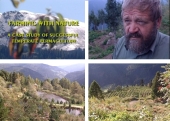




Middleburg, Florida (north of Daytona, west of Jacksonville)













 ). I try to turn it frequently & keep it moist.
). I try to turn it frequently & keep it moist.

























































 ?) I've heard of all sorts of ideas: a bucket or tupperware with tight lid, a container with carbon(?) filter on lid to let in air but not let out smell, etc.
?) I've heard of all sorts of ideas: a bucket or tupperware with tight lid, a container with carbon(?) filter on lid to let in air but not let out smell, etc.  ") And the compost pile is even more inaccessible than just the yard around it.... So that leaves peeing in a bucket somewhere and then dumping it. First thing is: it's best for others not to know too much about it. Which means keeping it tucked away on the porch where only I go, and dumping it before I leave the house everyday. BUT, here's the real problem I need advice on: the Noise when you're peeing in a bucket sounds Loudly Distinctly like someone peeing in a bucket. Has anyone else cleverly thought around this problem? Maybe a bunch of dry leaves I put at the bottom of the bucket everyday? I don't know....
") And the compost pile is even more inaccessible than just the yard around it.... So that leaves peeing in a bucket somewhere and then dumping it. First thing is: it's best for others not to know too much about it. Which means keeping it tucked away on the porch where only I go, and dumping it before I leave the house everyday. BUT, here's the real problem I need advice on: the Noise when you're peeing in a bucket sounds Loudly Distinctly like someone peeing in a bucket. Has anyone else cleverly thought around this problem? Maybe a bunch of dry leaves I put at the bottom of the bucket everyday? I don't know....



~ Spiralmama Herbal Magick ~
Supporting vibrant health in my community by providing education, nutrition, herbal connection and ritual through grateful interaction with Gaia.




 ), FREE, neatly packaged, FREE, and in great supply, despite being FREE. Some people say that UCG is more greenish-brown, kinda having both, but if the scales tip towards having enough nitrogen to ultimately classify it as green, I'll take it! Something's better than nothing, especially when it's FREE.
), FREE, neatly packaged, FREE, and in great supply, despite being FREE. Some people say that UCG is more greenish-brown, kinda having both, but if the scales tip towards having enough nitrogen to ultimately classify it as green, I'll take it! Something's better than nothing, especially when it's FREE.











"Although the world is full of suffering, it is full also of the overcoming of it." - Helen Keller
--
Jeremiah Bailey
Central Indiana








[img]http://i109.photobucket.com/albums/n52/havlik1/permie%20pics2/permiepotrait3pdd.jpg[/img]
"One cannot help an involuntary process. The point is not to disturb it. - Dr. Michel Odent




Brenda
Bloom where you are planted.
http://restfultrailsfoodforestgarden.blogspot.com/




"Although the world is full of suffering, it is full also of the overcoming of it." - Helen Keller
--
Jeremiah Bailey
Central Indiana





"the qualities of these bacteria, like the heat of the sun, electricity, or the qualities of metals, are part of the storehouse of knowledge of all men. They are manifestations of the laws of nature, free to all men and reserved exclusively to none." SCOTUS, Funk Bros. Seed Co. v. Kale Inoculant Co.




"Although the world is full of suffering, it is full also of the overcoming of it." - Helen Keller
--
Jeremiah Bailey
Central Indiana
 1
1








"the qualities of these bacteria, like the heat of the sun, electricity, or the qualities of metals, are part of the storehouse of knowledge of all men. They are manifestations of the laws of nature, free to all men and reserved exclusively to none." SCOTUS, Funk Bros. Seed Co. v. Kale Inoculant Co.












MJC wrote: I ended up with 18 tomato and one spaghetti squash plant...Obviously I am not hot enough...
"the qualities of these bacteria, like the heat of the sun, electricity, or the qualities of metals, are part of the storehouse of knowledge of all men. They are manifestations of the laws of nature, free to all men and reserved exclusively to none." SCOTUS, Funk Bros. Seed Co. v. Kale Inoculant Co.








TCLynx
 2
2




Seed the Mind, Harvest Ideas.
http://farmwhisperer.com









Sustainable Plantations and Agroforestry in Costa Rica





|
Would anybody like some fudge? I made it an hour ago. And it goes well with a tiny ad ...
The new permaculture playing cards kickstarter is now live!
https://www.kickstarter.com/projects/paulwheaton/garden-cards
|






